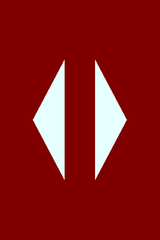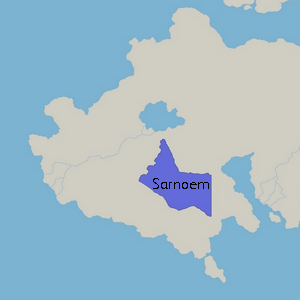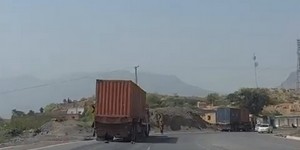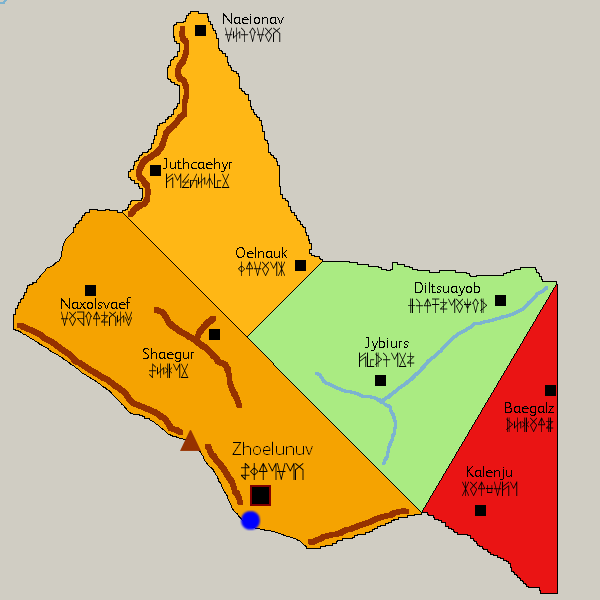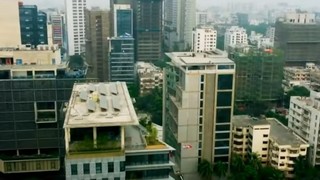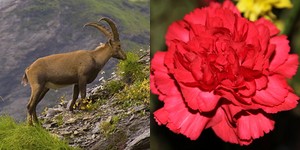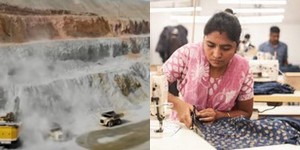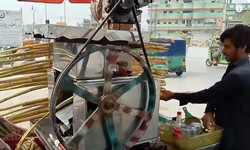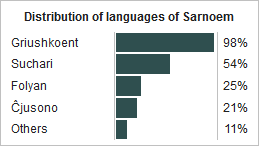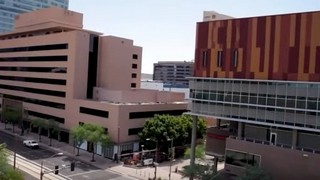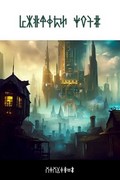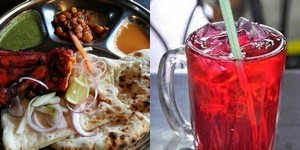Demographics
Distribution of languages in Sarnoem. |
Bilingual signs like these in the airport are available everywhere. This one has Folyan, which appears more in the western parts of the country. |
The official language of Sarnoem is Griushkoent, which is spoken by 98% of the population. Everyone is at least bilingual, as learning a 2nd language is essential in all schools. Foreign languages such as Suchari (54%), Folyan (25%) and Ĉjusono (21%) are on the rise due to increase in exposure and availability to media in said languages. Other dialects are also spoken here due to the country's policy of welcoming the immigration of refugees. Although Griushkoent itself has a native culture attached to it, its usage has expanded within a multicultural society. Aside from that, the language ensures that its own units of measurement are widely used instead of international units.
Those who identify with the mainstream Sarnoeme ethnicity, even mixed lineage, are sorted into one group collectively (89%). A large majority of the population (around 75%) are aligned with the xaend religion, while any cultural census simply categorises all the other religions as "non-xaend". Xaend is known to have hints of monotheism and animism mixed in, often with local and regional differences. Xaend adherents are discouraged from worshipping a deity, but altars and memorial pikes are a common sight out in the fields or even near buildings. According to xaend folk, they believe that there were supreme entities that once brought advanced civilisation to ancient humanity. Myths and legends from xaend, such as said "Mystical origins beyond the lake", still impact central themes of stories and aesthetics until this day.
The educational system in Sarnoem consists of 3 stages. Primary school lasts 5 years and begin at the age of 6, then continuing on to secondary school for another 5 years. After more than 5 years completing the pre-university and university stages, the typical student graduates at the age of 22. An academic year begins in spring and ends at early winter. Students study few broad subjects in primary school, then having a choice of around 10 of 20 subjects in secondary school to prepare for the standardised examination based on the common framework curriculum.
|
A Griushkoent novel entitled "Ykgloemae yoiz". |
Zhoelunuv Ijmunt (Zhoelunuv University) is amongst the top 100 universities in international rankings, especially with regards to the natural sciences and humanities fields. The other highly ranked university, Sarnoem National University, is located in Fiabelsyrtaens and is known for having the largest archive of Griushkoent academic journals. However, most engineering and medical courses are not internationally recognised, so graduates from these programmes usually only reside in-country. Although many alternative qualifications are accepted, international student admissions remain below average because course lessons are in the Griushkoent language which is not familiar to most foreign students. Unlike other countries, all undergraduate degree programmes result in certification at the masters level instead of the bachelor's level.
Culture
Kuyuj (skewered meat) and hibiscus juice. |
Partners showing freestyle moves of an Ovoezgysh dance, which is both a performance and a sport. |
A flatbread made from wheat is a staple food and a full meal is commmonly served with meat, vegetables and spiced sauce. Due to its distance from the ocean, seafood is not widely available, but lancelet and river fish are considered a delicacy here. Some commonly served dishes are cayadoeth (chilli beef), jugas (spicy noodles), fuyiaf (butter flatbread), and juboupsouth (layer pastry). Drinks such as kaung tea, sugarcane juice and malt beverages are popular and drunk daily. Nowadays, there is an increased number of box cuisine restaurants and street food stalls in towns, alongside fast food and fusion franchises from other countries.
As a large exporter of textile products, the fashion industry supplies 60% of the country's clothing demand. There is no distinction in formality when it comes to clothing in Sarnoem, and one's clothing represents the style of a person or the branding of the area. Men usually choose to wear a simple cotton coat with trousers, or a vophang (long ankle-length shirt), or a souloet (similar to a vophang, but shorter). Similarly, women are seen wearing a floral dress, or a zeyouzh (loose bathrobe), or sometimes a souloet that is decorated with extra frills.
Foer ball is the most popular sport in the country, which involves kicking amongst 2 balls to score goals by a team of 10 players. There are several regional modifications to this sport, for example allowing multiple throwing players, having variable goalkeepers, adding a 3rd ball or placing terrain obstacles onto the court. The national football team participates in the CEFA World Cup and reached the finals a few times. In recent years, extreme sports have begun to surge in engagement rates amongst the urban youth.
The country uses the Sarnoemi Calendar which begins in spring and ends on a variable date in the winter. In this calendar, years are not divided into months or weeks, merely showing the year, season and day number. Note that the season names are only for translational convenience as true continental seasons don't exist in its climate zone. Sarnoemi years (SY) are 720 years behind the international calendar for historical reasons. Moreover, clocks in Sarnoem are calibrated according to the 20 daypart system and the zeroth hour starts at dawn. Celebrated holidays are Flower Festival on 1 Spring, Independence Day on 25 Summer, Ghost Festival on 48 Autumn and Gift Festival on 23 Winter.
Griushkoent literature spans more than a thousand years including prose, poetry, drama and other short works. Ykgloemae yoiz, a novel based on a famous retold classic, by award-winning author Voevroegez, sold tens of million of copies worldwide and has been translated to other languages. Fantasy and science fiction remain a popular genre amongst contemporary readers as well as publication houses. The annual Literacy Day on 11 Summer helps preserve not only the main languages, but also other lesser used languages that are spoken in Sarnoem.
Sarnoemi paintings tend to be surreal and abstract, while also displaying more geometrical motifs then blending with nature. Folk music in this region involving acoustic groups playing unplugged songs can be heard in most places, but notwithstandingly pop music from other countries are increasingly topping the album sales charts. TV drama shows continue to be avidly watched amongst adults, especially those with overarching storylines, often with more than 50 episodes. The step dances of Ovoezgysh, which includes non-contact movements and interlocking stances, are vigorous enough to be practised in sport performances.
Ghost festival decorations, as shown in this postcard. |
Roetoursh is the tallest building (400 m) in Sarnoem. It displays xaend-based geometrical architecture. |
